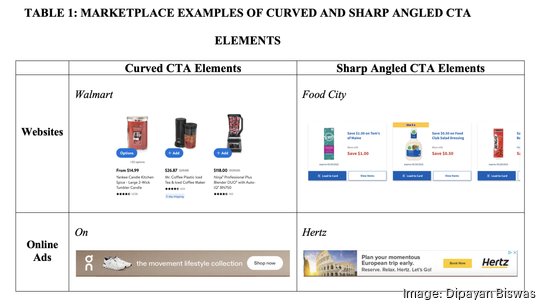
A researcher at the University of South Florida has discovered a key for websites to capture extra clicks and possibly make more sales: online curves.
Dipayan Biswas, the principal researcher on this study and an endowed marketing professor, studies digital advertising. He's interested in sensory marketing, as well as what he calls "nonconscious outcomes," or reactions to parts of an advertisement like color or shape. His report, published in December in the Journal of Consumer Research, points to this consumer behavior as pertinent to all businesses.
"If you're trying to encourage avoidance, go for sharp, angular elements," Biswas said. "But if you're like the overwhelming majority of businesses where you want your customers to click on something to get more information, make contact, any kind of approach behavior, definitely go for curved elements as much as possible for your websites."

A few years ago Biswas was sitting at his computer and noticed the two variations on websites. There were curved, rounded "call to action buttons" (the buttons you click to "read more" or complete the purchase) and sharp, angular others. He set out to see if there was correlated behavior with either. He found no comprehensive research and that most companies seemed not to give it much thought, he said.
"It's surprising; no one has ever looked into this, but I'm sure it's picking up because there is a severe transition to online shopping," Biswas said. "[Online shopping] is already at around 20% to 25% of all spending. So there would be more interest, while physical retail still dominates, but there's been a gradual shift over the years."
The experiment results from a research partnership with an unnamed major hotel chain, a Google ad study partnered with a Tampa Bay area restaurant, and a project studying eye movement at the school's "customer experience lab." It used a diverse and random sample population and saw consistent results. It repeatedly found people are more inclined to click areas with softer, rounder edges without realizing it.
For the hotel, it translated to an increase of nearly 15 percent in total revenue, Biswas said.
“It’s actually rooted in natural and evolutionary instincts,” said Biswas. “According to research from different disciplines, our natural instincts send us signals that sharp angles usually denote danger and that we’re more likely to get hurt. In contrast, curvy designs are perceived as friendlier and more approachable.”

It's a way to influence customers easily — and grab one extra sale — for the companies that consider it, Biswas said.
There are a few other things to consider, too, like color. Colors like red might cause subconscious feelings of excitement, while blue can be relaxing, Biswas said.
"Surprisingly, there is very little research on the digital side [of advertising], and there has been a lot of work on the physical side," Biswas said. "[But] what you can do in the digital environment, the main variable actually will be visual in nature."
Even with the curves and colors, Biswas has a greater takeaway for businesses: the ease of digital advertising.
"I would suggest for startups especially, that digital advertisements are often cheaper and more manageable and more targeted than traditional non-digital advertising," Biswas said.




